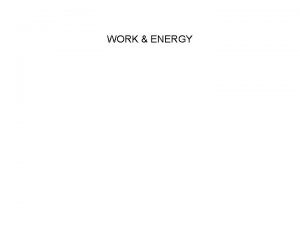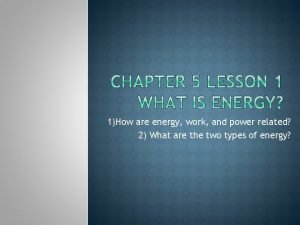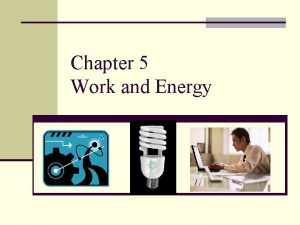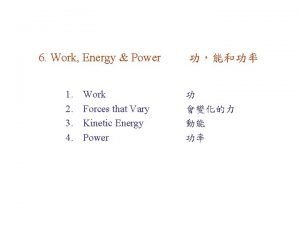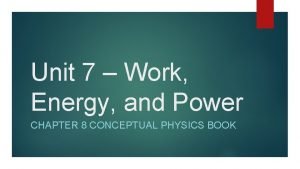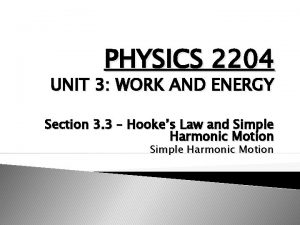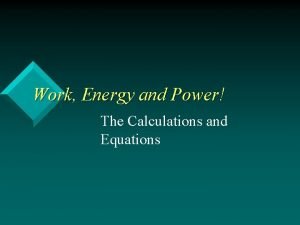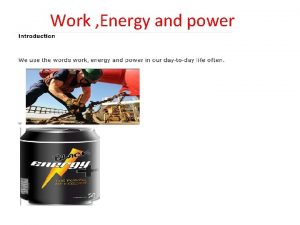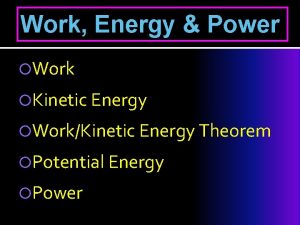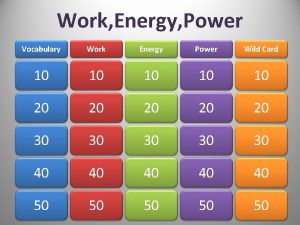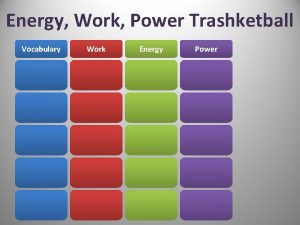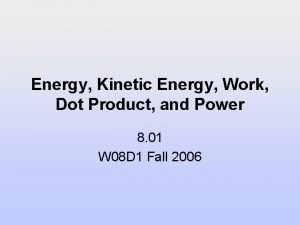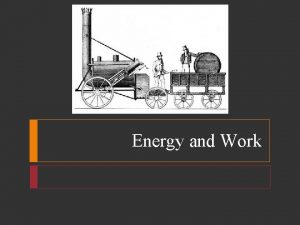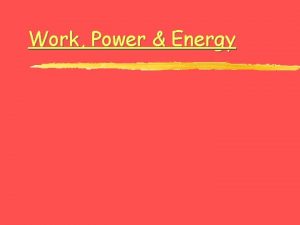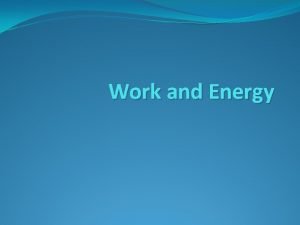Work Energy and Power Work W The product
















- Slides: 16

Work, Energy, and Power

Work (W) The product of the force (F) applied to an object over a distance (d) in which the object travels as a result of the force (Force and distance must be parallel to each other) Joule (j) is the base unit of work: 1 Joule = 1 Newton x 1 Meter 1 J=1 Nx 1 m 1 J = 1 Nm

Work Example A student lifts a 50 pound (lb) ball 4 feet (ft) in 5 seconds (s). How many joules of work has the student completed? Convert English units to SI units Solve for Work

Energy Ability to do work (light, heat, mechanical, chemical, electrical) Roller coaster NASA solar sail Fuel cell

Forms of Energy Potential Energy (Stored energy or gravitational energy) The capacity to do work by virtue of position or configuration

Forms of Energy Kinetic Energy (Energy of motion) Energy which a body possesses because of its motion, which occurs anywhere from an atomic level to that of a whole organism

Energy Transformation Chemical Radiant Electrical

Renewable Energy Sources Biomass Hydropower Hydropowe Wind Geothermal Solar

Nonrenewable Energy Sources Coal Petroleum Natural Gas Uranium

Conservation of Energy cannot be created or destroyed, but it can change from one form to another. Energy Conversion Changing one form of energy to another Energy Efficiency: The ratio of the useful energy delivered by a dynamic system to the energy supplied to it Entropy: The loss of energy during conversion

Energy Conversion Examples Fossil fuels Solar cells Wind turbines Hydroelectric Nuclear Chemical → Heat → Mechanical → Electrical Sunlight → Electrical Kinetic → Mechanical → Electrical Gravitational potential → Mechanical → Electrical Nuclear → Heat → Mechanical → Electrical Vehicle System Conversion Chemical Mechanical Heat Which output is desired, mechanical or heat?

What Are Current Energy Concerns? Consumption Pollution Depletion Dependency Cost http: //www. eia. doe. gov What roles do engineers have in energy?

Power Rate at which work is performed or energy is expended Watt is the base unit of Power One watt is equal to 1 joule of work per second

Types of Power Electrical Power Uses electrical energy to do work Mechanical Power Uses mechanical energy to do work (linear, rotary) Fluid Power Uses energy transferred by liquids (hydraulic) and gases (pneumatic)

Power Example A student lifts a 50. 0 pound (lb) ball 4. 00 feet (ft) in 5. 00 seconds (s). How many watts of power are used to lift the ball? Power = Work / Time Work = 271. 45 J

Resources Mc. Graw-Hill dictionary of engineering. (2 nd ed. ). New York, NY: Mc. Graw-Hill. Microsoft, Inc. (2008). Clip Art. Retrieved January 10, 2008, from http: //office. microsoft. com/en-us/clipart/default. aspx National Aeronautics and Space Administration (NASA). (1997). Daedalus. Retrieved April 2, 2008, from http: //www. dfrc. nasa. gov/Gallery /Photo/Daedalus/ U. S. Department of Energy. (2008). Scientific forms of energy. Retrieved March 23, 2008, from http: //www. eia. doe. gov/kids/energyfacts/science/formsof energy. html
 Draw the power triangle
Draw the power triangle Section 4 review physical science
Section 4 review physical science Energy energy transfer and general energy analysis
Energy energy transfer and general energy analysis Energy energy transfer and general energy analysis
Energy energy transfer and general energy analysis Work, power and energy activities
Work, power and energy activities Definition of work power and energy
Definition of work power and energy How are energy work and power related
How are energy work and power related Work power energy and machines
Work power energy and machines W=fdcosθ meaning
W=fdcosθ meaning Work power and energy
Work power and energy Jenis usaha apa
Jenis usaha apa Work and energy section 2 describing energy answer key
Work and energy section 2 describing energy answer key Physics 03-01 work and the work-energy theorem
Physics 03-01 work and the work-energy theorem Regents physics work power energy
Regents physics work power energy Unit of resistivity
Unit of resistivity Physics 2204 unit 3: work, power, energy
Physics 2204 unit 3: work, power, energy Work energy power equations
Work energy power equations




